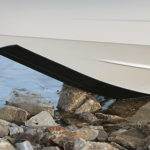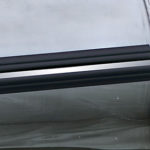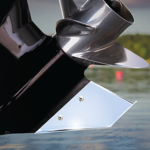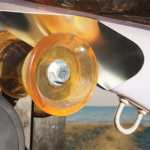Using Blade Baits to Catch Cold Bass
In locations across the country that suffer from ice covered lakes and frigid water temperatures, blade baits become a perennial favorite among bass anglers before and after the ice. Much has been said about the blade bait in previous blog articles:
Winter Bass Fishing: A Winter with Bite
Late Fall Fishing on Natural Lakes
But even with mentions in multiple articles, few details about blade baits were offered. Well, here come the details.
Using Blade Baits
Admittedly, a blade bait is not much to look at. It’s just a chunk of skinny steel with lead attached to give it weight. However, the simple combination produces a violent vibration when moved through the water that bass have a hard time resisting.
It is perfect for the scenario. As bass cling close the bottom with a low metabolism and unwillingness to chase food, the blade bait is bounced in front of their faces. This triggers a reaction bite even when bass are not in a feeding mood. Bass are on the bottom waiting for an easy meal, and the blade bait mimics that perfectly. It is deadly for both Largemouth and Smallmouth Bass.
Retrieving Blade Baits
Cast the bait as far as possible. Let it settle to the bottom. Hold the rod at the 9 o’clock position and lift it until the vibration can be felt, normally the 11 o’clock position. Then let it flutter to the bottom. Repeat.
If the vibration comes earlier, stop. In deep water it may require lifting to 12 or 1 o’clock. In shallow water, the opposite will be true.
Color Selection for Blade Baits
The Original Silver Buddy is the first mainstream blade bait, and the most popular color is as the title suggests: silver. This color mimics shad that often die in cold water as well as minnows. If I am ever on a body of water where the main forage is a mystery, I always go with silver.
However, if I am on a fishery where bass frequently focus on perch, then a perch colored bait is my first pick, but gold is a close second. If in ultra-clear water, a bright fluorescent green can coax bites. Be warned, though, the bright green will also drive crappie, perch, pike, and walleye nuts. Expect bites from multiple species. Red can also stir a reaction from more than just bass, especially in stained water.

Choosing Blade Bait Sizes
A ½ ounce model blade bait gets the nod from me 90% of the time. It sinks about one foot per second, which has proven to be a winner. However, there are times to get heavier. Whenever in excessive wind or depths deeper than 20 feet, the ¾ ounce models get the nod.
Waves in excess of one foot high will keep the bait off the bottom, thus the heavier bait comes into play. Also, when deeper than 20 feet, it takes too long to get it to the bottom. Not only does it take 20 seconds to reach bottom, as does any bait, it careens towards the boat as it flutters down. This eliminates how much water can be covered during a cast. The heavier weight gets down faster and stays down.
Tips for Using Blade Baits
Losing fish on the blade bait is a habitual challenge, but it can be minimized with the following tips:
- Be sure the hooks are attached with split rings! This will provide some flexibility as fish thrash their heads. Size 3 will work on most.
- Use quality hooks. Generic hooks do not pierce a fish’s mouth sufficiently, so replace with similar sized hooks.
- Replace the belly hook with a red hook. It is a slight change but can pay huge dividends. Countless times I have experienced a more aggressive bite with this addition.
- Use a 7-foot Medium Heavy Rod. The rod must have a fast tip to ensure long casts.
- Monofilament and braid line float, which is polar opposite to the action of this bait, so fluorocarbon line is a must. 12-pound test is sufficient for most applications.
Cold water fishing can be intimidating for most, but for the angler that has the proper gear, including a protected boat with Megaware products, opportunity still exists for catching fish.







Comments